|
Leffingwell &
Associates
|

Alchemist WebPick Awarded by
the webzine of ChemWeb.com

|
Boronia
A Review by John C. Leffingwell, Ph.D.
This a part of our series on aroma materials
produced by carotenoid degradation.
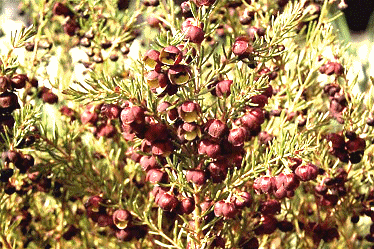
Boronia megastigma
There are approximately 95 species of Boronia (Family Rutaceae),
all but one of which occurred originally only in Australia. The
majority of Boronia species are found in south-western Australia. The
Brown Boronia (Boronia megastigma) is intensely fragrant (like
Freesia and Osmanthus) and is valued in Australian floral
arrangements for its intense aroma. The fragrance of B. megastigma is
not as appreciated in the rest of Asia. Brown Boronia is produced
almost exclusively in the area of Australia depicted.
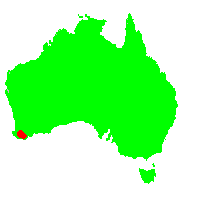
Click
here for an excellent drawing of brown boronia.
The primary flower produced for both domestic & export is
Boronia heterophylla which has fairly long stems of vibrant pink
flowers and are more attractive than B. megastigma yet still
possesses good fragrance. B. heterophylla is cultivated in both
south-east and southwest Australia for the cut flower trade. B.
heterophylla is a shrub that often reaches 6 feet (2 meters) in
height
In contrast, B. megastigma is a small shrub which rarely exceeds a
3 feet (1 meter) in height. It has small leaves which are also
aromatic and small cup-shaped flowers. The flowers are about 80-100
mm diameter. Usually, the exterior of the petals is a dark
chocolate-brown in colour while the interior is bright yellow.
Although widely cultivated, B. megastigma is not really suitable for
sub-tropical and tropical climates. Julie
A. Plummer of the University of Western Australia has developed
an interesting guide for The Rural Industries Research &
Development Corporation that outlines growing considerations for
Boronias.
For flavor and fragrance use, the flowers of Boronia megastigma
are collected, extracted with petroleum ether ( a hydrocarbon
fraction), concentrated into a waxy concentrate (a concrete) and then
the concrete is re-extracted with alcohol, and concentrated to form
Boronia absolute. The absolute is typically a dark green semi-fluid
liquid that possesses a fruity, tea-like, slightly herbaceous odor.
In perfumes, boronia is used in violet, mimosa and honeysuckle bases,
while for flavors it adds body and naturalness to flavors such as
raspberry, strawberry, peach, etc.
At one point in time, as many as 500 flower collecting stations
were present in southwest Australia, where the flowers were collected
from the wild, immersed in drums of petroleum ether and the drums
sent to extraction stations (in Perth). This has been replaced with
plantations that grow B. megastigma exclusively for production of the
absolute. The best known of these is in Tasmania, an island off the
southwestern tip of Australia.
Recently, it has been shown by Robert
Menary that increases in extract and volatiles after harvest from
hydrolysis of glycosidically bound volatiles or de novo synthesis can
increase the extract volatiles by as much as 20%.
While it has been known for many years that boronia contains
beta-ionone, only in the last few years has a more complete
accounting of other compounds derived from carotenoid degradation
been documented. The following chart shows the aroma constituents
formed via degraded carotenoids.
Boronia Constituents from
Carotenoids
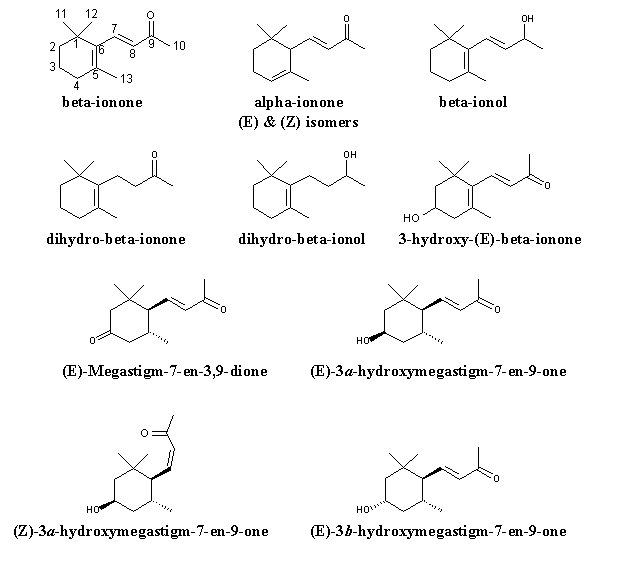
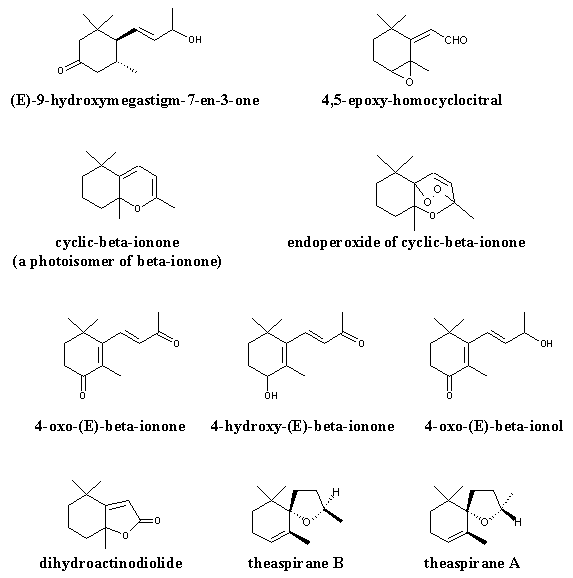
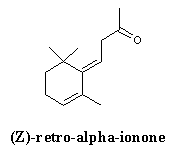
While aroma constituents formed from carotenoids are perhaps
the most important to the aroma of boronia, the absolute also
contains a number of linalool related materials ( linalool, linalyl
acetate and a series of 8-hydroxylinalool esters) and compounds in
the methyl jasmonate series depicted below that undoubtedly impact
the odor profile substantially.
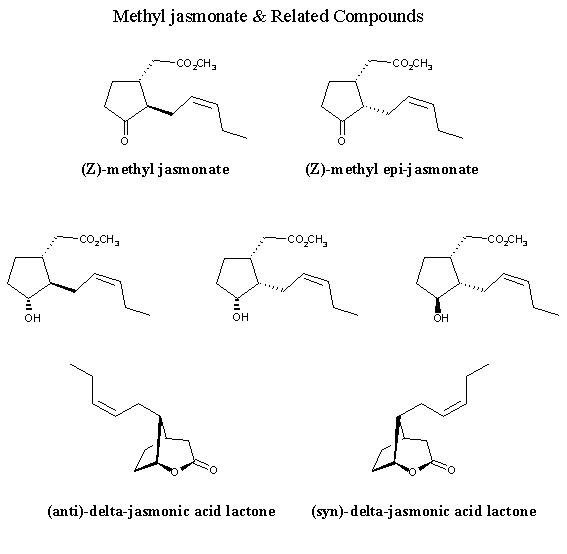
References:
B. Lawrence, Progress in Essential Oils, Boronia, Perfumer &
Flavorist, 24(1), 53-55 (1999)
P. Weyerstahl, H. Marschall, W-R. Bork, R. Rilk, S. Schneider and
H-C. Wahlburg, Constituents of the absolute of Boronia megastigma
Nees from Tasmania. Flav. Fragr. J., 10, 297-31131 (1995).
P.Weyerstahl,H. Marschall,W-R. Bork and R. Wilk, Megastigmanes and
other constituents of the absolute of Boronia megastigma from
Tasmania. Liebigs Ann. Chem., 1043-1047 (1994).
B. Lawrence, Progress in Essential Oils, Boronia, Perfumer &
Flavorist, 8(2), 61 (1983)
N.W. Davies and R.C. Menary, Volatile constituents of Boronia
megastigma flowers, Perfumer & Flavorist, 9(1), 3-8 (1983)
G. W. Leggett and R. C. Menary, Boronia, Production-Its growth and
oil characteristics, Paper No. 36. 8th International Essential Oil
Congress, Cannes (1980).
S. Arctander, Perfume and flavor materials of natural origin, S.
Arctander, Pub., Elizabeth, NJ, pp. 104-105 (1960)
Back to The Carotenoids
Page...... Home
.......Back
to In the News
Copyright © 1999-2001
by Leffingwell &
Associates
|
Other Subjects on the
Leffingwell & Associates Site
|
Telephone:
01-770-8895111 - Email:
leffingwell@mindspring.com
Copyright © Leffingwell &
Associates
TERMS OF SERVICE.............PRIVACY POLICY






